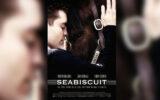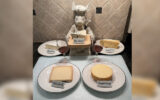Back in the April edition of Evince, I wrote about a house that is no more. This month, I write about a restaurant that is no more: “Erma’s Restaurant.”
My writing about these two demolitions within a specific range of time only reflects the specific range of time in which they occurred. It doesn’t mean that my writing is now headed in such a singular direction as to cause the public to assume, “Whenever the wrecking ball wrecks, Williams writes!”
Prior to Erma’s closing, I had heard years ago that it was a “biker” tradition. When I first heard that, having spent at least half of my childhood in the 1950s, my “mind’s eye” saw Marlon Brando’s character Johnny Strabler in The Wild One (1953), with a trophy strapped to his motorcycle as a kind of unusual “hood ornament.” The top of the trophy consisted of a rider astride a motorcycle, the whole resembling a kind of “biking Oscar.”
From time-to-time, my travels might take me past Erma’s. At such times, I would often see men in black and black leather out front standing next to some really fine “hogs” and “choppers.” If you don’t know what those terms mean, I refer you to the film Easy Rider (1969) and the rock band Steppenwolf (whose songs comprised the music of the film’s soundtrack).
But, as not everyone “bikes,” it could be said that Erma’s attracted people who enjoyed just being in the company of others, neighborhood friends going there as a group, or “Erma’s friends,” those only encountered at Erma’s! In that respect, Erma’s was Danville’s version of the English pub or the German hofbrau.
I popped in there wearing a biker vest one time; but I’m sure they saw right through me!
Behind the front counter was a board with a list of proper names with the heading: “The following people are not allowed in Erma’s!” These were evidently individuals who had visited Erma’s and had not respected the good cheer fostered there. As is the “just in case” part of human nature, even though I knew I had never caused a ruckus at Erma’s, I was glad not to see my name listed.
The large “spire-like” metal projection on the roof of Erma’s kind of reminded me of a giant hood ornament. And as to my “spire” reference, it might be said that Erma’s was a cathedral of sorts, where people gathered to promote goodwill.
Erma’s had the message “Air Conditioning” cursively painted on the outside of the building. That, and the building’s style, makes me think Erma’s was built in the 1950s, when air conditioning was a “newer sort of thing.” And as to the cursively written message, sadly, to those who were in recent years never taught cursive, that sign might have been as decipherable as ancient cuneiform!
There are business advertisements which proudly proclaim: “The combined proficiency of our staff represents over 100 years of experience” (usually, unnervingly made by funeral establishments). In that respect, the combined life experiences of Erma’s’ patrons during the course of Erma’s lifetime would push Erma’s origin back as far as that of The Great Pyramid of Giza (another storied monument, but mostly still intact).
I recently visited Erma’s in its destruction; and on its 2nd or 3rd day of destruction that shiny metal “roof ornament” had already been toppled to the ground. Its lumbered backing support giving it the appearance of a movie prop; but Erma’s was real, through and through, nothing of show biz’s phony facade!
I picked up a few pieces of broken, blue-painted cinder block to give to family and friends. They looked like those broken pieces of the Berlin Wall which are still selling on the internet (don’t worry, I didn’t get “ideas”).
Whereas that cinder block wall running through the city of Berlin was built to keep people in against their will; the cinder block portion of Erma’s Restaurant figuratively “nestled” and “hugged” a much sought-out space in which camaraderie and the joy of life were celebrated.






